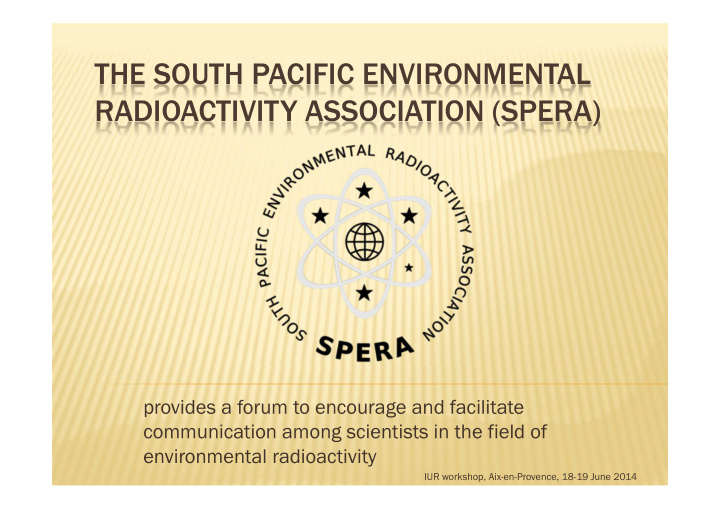



THE SOUTH PACIFIC ENVIRONMENTAL RADIOACTIVITY ASSOCIATION (SPERA) provides a forum to encourage and facilitate communication among scientists in the field of environmental radioactivity IUR workshop, Aix-en-Provence, 18-19 June 2014
OBJECTIVES Encou oura rage and facilitate communication on and coop opera ration on among scientists work rking in the South Pacific region in the field of environmental radioactivi vity which involves the study of the occurre rrence, behavi viou our and impact of radioactive species present in the environment either due to natural processe ses or as a result of human activi vities. The South Pacific region is deemed to include all countri ries in, or borderi ring on, the South Pacific Ocean.
THE REGION No nuclear power production, but . . . 21 of recent 27 new NPPs connected to grid in Asia > ¼ of world’s U resources in Australia Weapons test sites (Maralinga, Mururoa....) Research Reactors (ANSTO, Serpong)
ABOUT SPERA Small, non-for-profit, apolitical, scientific organisation Workshops held in 1985 in Sydney and 1990 in Adelaide 1991 meeting in Tahiti: drafting of SPERA constitution 1992: SPERA was registered in South Australia SPERA: Incorporated Association under SA law MoU with IUR in 2012
ACTIVITIES (a) conduct regular work rkshop shops, s, sympos osia and confere rences (b) b) establish Work rking Groups to carry out joint studies & scientific exchange (c) organise inter-com ompari riso son programs for QA (d) provide advice & inform rmation on on environmental radioactivity issues to scientists in the South Pacific region and elsewhere re
SPERA CONFERENCES & WORKSHOPS 1985: Environmental Radioactivity workshop in Sydney 1990: Environmental Radioactivity workshop in Adelaide 1991: 1 st SPERA meeting in Tahiti 1992: Conference in Dunedin - New Zealand 1994: Canberra – Australia 1996: Darwin & Jabiru - Australia 1998: Christchurch - New Zealand 2000: Noumea - New Caledonia 2002: Sydney - Australia 2004: Valdivia - Chile 2006: Melbourne - Australia 2008: Christchurch - New Zealand 2010: Gold Coast, Australia 2012: Sydney – Australia 2014: Darwin (13 th SPERA conference)
SPERA 1996 DARWIN
SPERA 2008 CHRISTCHURCH
SPERA MEMBERS & SUPPORT ARPANSA SA - Australian Radiation Protection and Nuclear Safety Agency, Melbourne/Sydney ANSTO - Australian Nuclear Science & Technology Organisation, Sydney AINSE SE – Australian Institute of Nuclear Science and Engineering eriss ss - Environmental Research Institute of the Supervising Scientist, Department of the Environment, Darwin ANU - Australian National University, Canberra ARPS - Australasian Radiation Protection Society NCRS - National Centre for Radiation Science, Christchurch, New Zealand CSIRO, Qld Health, SA EPA, Universidad Austral de Chile . . . .
ERISS The Environmental Research Institute of the Supervising Scientist ( eriss ) is part of the Science Division of the Gov’t Department of the Environment. Undertake research & monitoring into the impact of uranium mining activities in the Alligators Rivers region to protect human & eco-system health Provide advice to the Supervising Scientist and other Government Agencies on EPBC related matters Development of closure criteria for the safe rehabilitation of Ranger U mine
ANSTO The Australian Nuclear Science and Technology Organisation is an agency within the portfolio of the Minister for Industry, responsible for delivering specialised advice, scientific services & products to industry, government, academia & other research organisations. Conduct research and development in relation to nuclear science & technology Produce and use radioisotopes, isotopic techniques & nuclear radiation for medicine, science, industry, commerce, agriculture Manage radioactive materials and waste arising from various prescribed activities
ARPANSA • ARPANSA is the Australian Government's primary authority on nuclear safety and security, radiation protection and emergency preparedness and response: o regulates C’wealth nuclear installations and facilities using radiation sources o provides radiation protection services o undertakes research • ARPANSA has a legislative responsibility to promote national uniformity and implementation of international best practice across all jurisdictions.
Australian National University The Department of Nuclear Physics, Research School of Physics and Engineering at ANU houses two AMS used for Environmental Physics/ Radioactivity projects Accelerator Mass Spectrometry Measures atomic ratios Ultra-trace level (ratios of 10 -12 to 10 -16 ) Isotopes measured: 10 Be, 14 C, 26 Al, 32 Si, 36 Cl, 41 Ca, 53 Mn, 59 Ni, 99 Tc, 129 I, 226 Ra, 228 Ra, 236 U, 239 Pu, 240 Pu, 242 Pu and 244 Pu http://physics.anu.edu.au/nuclear/research/ams/?tab=research
NCRS The National Centre for Radiation earthobservatory.nasa.gov: Akaroa caldera Science is part of the Institute of Environmental Science & Research (ESR), a government owned crown research institute, providing operational science and research services in New Zealand. Scientific advice to NZ regulatory body (Office of Radiation Safety) Personal Dosimetry Service CTBTO station operation Radiation Training Institute Calibration service Environmental Radioactivity Laboratory
EXECUTIVE COMMITTEE (2012-14) President Henk Heijnis ANSTO Vice President Andreas Bollhöfer eriss ss Secretary Stephen Tims ANU Treasurer Stephen Long ARPAN ANSA SA Committee Members Emmy Hoffmann ANSTO Peter Medley eriss ss
Recommend
More recommend